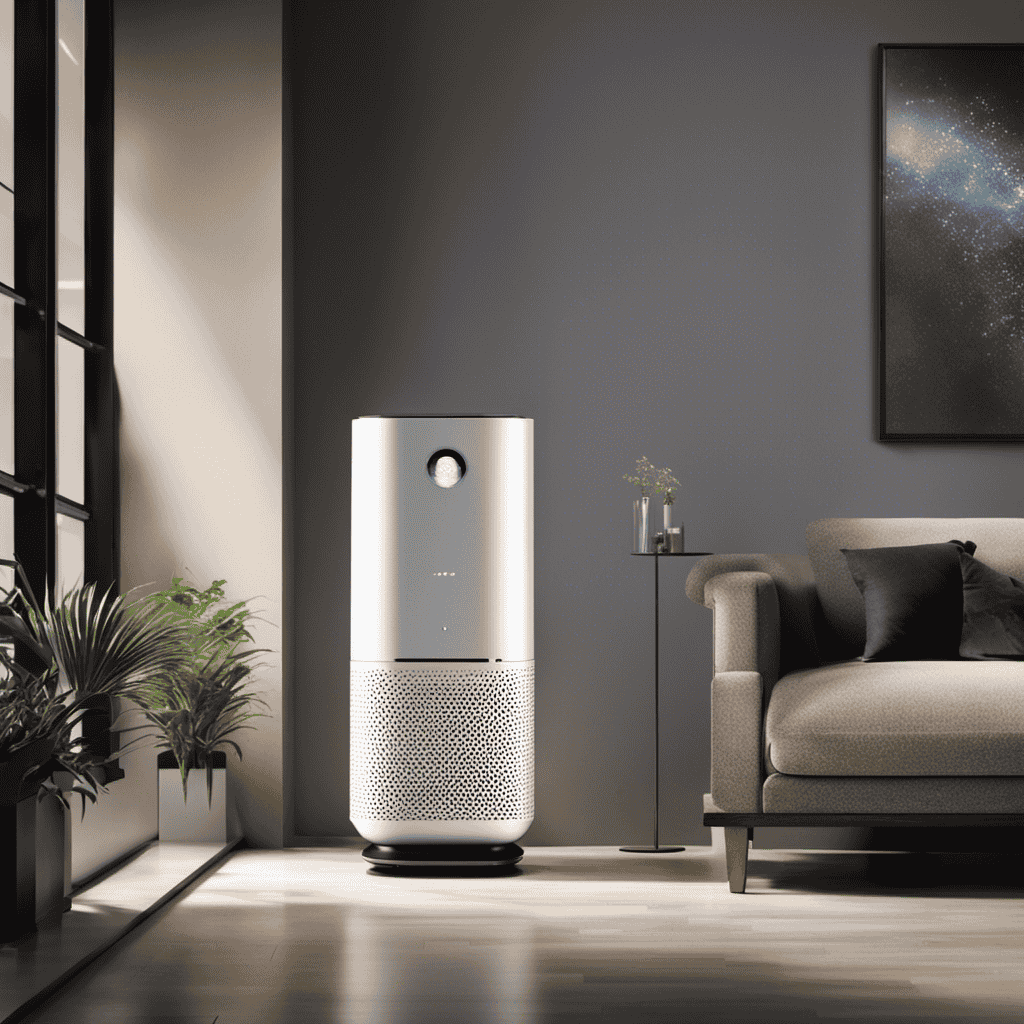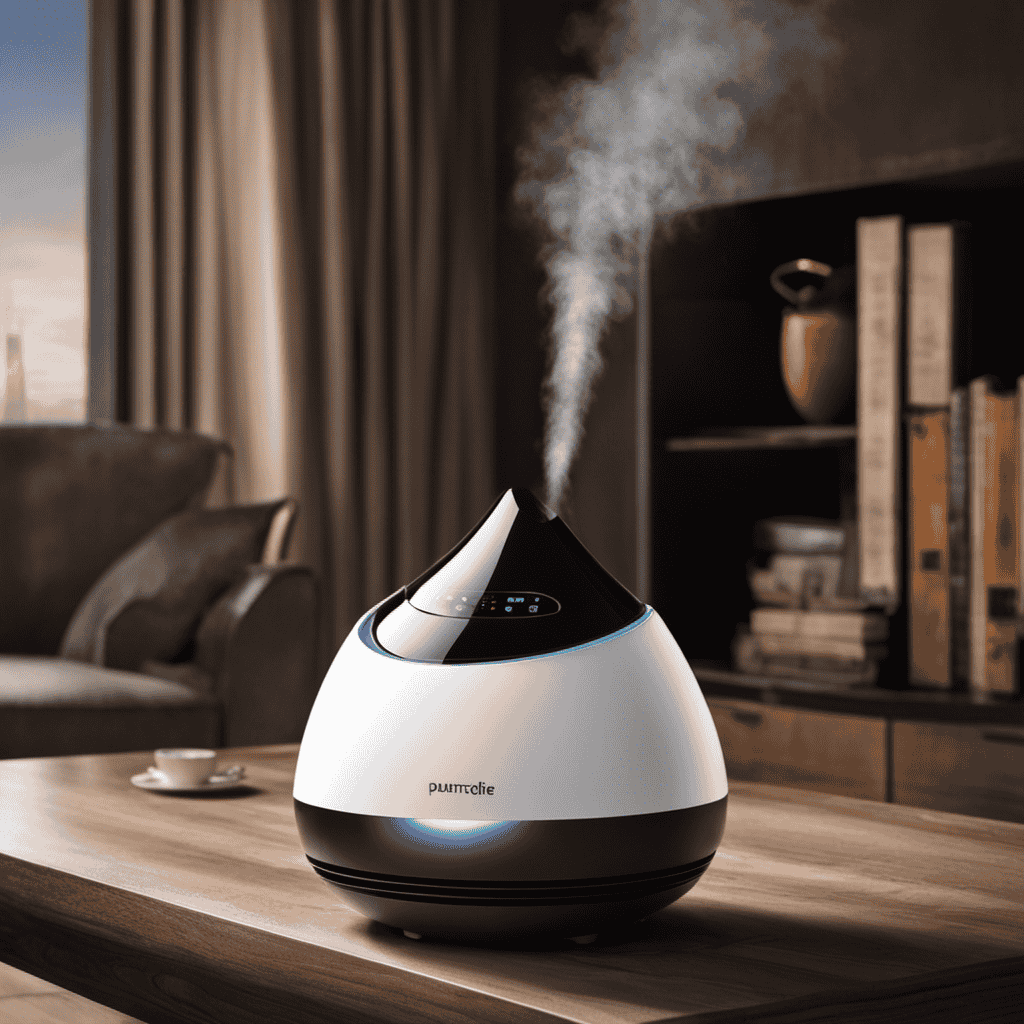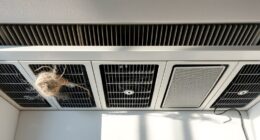Being knowledgeable about PM 2.5 on an air purifier is essential for keeping your indoor air clean and healthy. Learn why it’s important to grasp this term to improve your indoor air quality. Keep reading to find out more.
Did you know that PM 2.5 refers to particulate matter that is 2.5 micrometers or smaller in diameter? These tiny particles can pose serious health risks when inhaled, making it essential to have an effective air purification system in place.
In this article, I will delve into the intricacies of PM 2.5 and how air purifiers measure and combat this harmful pollutant.
Key Takeaways
- PM 2.5 refers to particulate matter with a diameter of 2.5 micrometers or smaller, and it is used to understand air pollution and its impact on human health.
- Long-term exposure to PM 2.5 can lead to respiratory conditions like asthma and bronchitis, as well as cardiovascular diseases.
- Vehicle emissions are a major source of PM 2.5 pollution, which poses health risks and contributes to global warming.
- Air purifiers with HEPA filtration and the ability to effectively filter out PM 2.5 particles are important for improving indoor air quality and preventing respiratory issues.
The Basics of PM 2.5
PM 2.5 refers to particulate matter that has a diameter of 2.5 micrometers or smaller. It is a crucial measure for understanding air pollution and its impact on human health. PM 2.5 measurement methods are used to quantify the concentration of these fine particles in the air. These methods typically involve collecting samples of ambient air and analyzing them in a laboratory setting.
The most commonly used techniques include gravimetric analysis, optical particle counters, and beta attenuation monitors. Air quality standards, set by regulatory bodies, establish the acceptable levels of PM 2.5 in the atmosphere to protect public health. These standards vary across different countries and regions, but they generally aim to limit the exposure to high concentrations of PM 2.5.
Understanding the measurement methods and air quality standards for PM 2.5 is essential in assessing and mitigating the risks associated with air pollution.
Understanding Air Pollution
As I delve into the discussion on PM 2.5 health effects and sources of air pollution, it is crucial to understand the scientific implications behind these topics.
PM 2.5, which refers to particulate matter with a diameter of 2.5 micrometers or less, has been linked to numerous health effects, including respiratory and cardiovascular issues.
These fine particles can originate from various sources, such as vehicular emissions, industrial activities, and even natural sources like dust and wildfires.
PM 2.5 Health Effects
You should be aware of the health effects of PM 2.5 on your body. PM 2.5 refers to particulate matter that has a diameter of 2.5 micrometers or smaller. These tiny particles can easily enter your respiratory system and have various detrimental effects. Here are three reasons why you should take PM 2.5 seriously:
-
Increased risk of respiratory diseases: Long-term exposure to PM 2.5 has been linked to the development of respiratory conditions such as asthma, bronchitis, and even lung cancer. These particles can penetrate deep into your lungs and cause inflammation, leading to chronic respiratory issues.
-
Cardiovascular problems: PM 2.5 can also enter your bloodstream and have a negative impact on your cardiovascular system. Studies have shown that long-term exposure to PM 2.5 increases the risk of heart attacks, strokes, and other cardiovascular diseases.
-
Reduced lung function: Breathing in PM 2.5 can impair lung function, especially in individuals with pre-existing respiratory conditions. It can lead to decreased lung capacity, making it harder for you to breathe and perform physical activities.
To protect your health, it is crucial to monitor and reduce your exposure to PM 2.5 according to established measurement standards.
Sources of Air Pollution
One of the major sources of air pollution is vehicle emissions. Vehicles, particularly those powered by fossil fuels, release a variety of pollutants into the atmosphere. These pollutants include carbon monoxide (CO), nitrogen oxides (NOx), and particulate matter (PM), specifically PM 2.5.
PM 2.5 refers to particles that have a diameter of 2.5 micrometers or smaller. These particles are tiny and can easily be inhaled into our lungs, posing a significant risk to our health. However, the impact of vehicle emissions goes beyond human health. They also have a detrimental effect on the environment, contributing to global warming and climate change.
As we delve deeper into how PM 2.5 affects our health, it is important to understand the sources of this pollution and their far-reaching consequences.
How PM 2.5 Affects Your Health
Breathing in PM 2.5 can negatively impact your health. This fine particulate matter, with a diameter of 2.5 micrometers or less, is present in the air we breathe and has been linked to various health risks.
Here are three ways in which PM 2.5 exposure can affect your respiratory system:
-
Increased risk of respiratory infections: PM 2.5 particles can penetrate deep into the lungs, causing irritation and inflammation. This can weaken the immune system and make you more susceptible to respiratory infections like bronchitis and pneumonia.
-
Worsening of existing respiratory conditions: For individuals with asthma, chronic bronchitis, or other respiratory conditions, inhaling PM 2.5 can exacerbate their symptoms. It can trigger coughing, wheezing, shortness of breath, and even lead to asthma attacks.
-
Long-term damage to lung function: Prolonged exposure to PM 2.5 can result in reduced lung function over time. It can lead to the development of chronic respiratory diseases, such as chronic obstructive pulmonary disease (COPD), and increase the risk of lung cancer.
It is crucial to minimize PM 2.5 exposure to protect your respiratory health and overall well-being.
The Importance of Air Purification
Using an air purifier can significantly improve the quality of indoor air. Clean air is essential for maintaining good health and preventing respiratory issues, especially for individuals with allergies.
Air purifiers play a crucial role in reducing allergies by effectively removing airborne particles, such as dust, pollen, and pet dander, from the air. These devices use advanced filtration systems to capture and trap these allergens, ensuring that the air we breathe is free from harmful substances.
How Air Purifiers Measure PM 2.5
As a scientist, I understand the importance of PM 2.5 in air quality monitoring. PM 2.5 refers to fine particulate matter that is 2.5 micrometers or smaller in size, which can be harmful to human health when inhaled.
When it comes to air purifiers, accuracy in measuring PM 2.5 is crucial to ensure effective purification and provide reliable information for users.
Importance of PM 2.5
To understand the importance of PM 2.5, you should know that it refers to particulate matter smaller than 2.5 micrometers in diameter. Clean air is crucial for our overall well-being, and reducing PM 2.5 levels can have significant health benefits.
Here are three reasons why PM 2.5 is important:
-
Respiratory Health: PM 2.5 particles are small enough to enter our respiratory system and can cause various respiratory problems such as asthma, bronchitis, and even lung cancer. Breathing in clean air with low PM 2.5 levels can help prevent these issues.
-
Cardiovascular Health: PM 2.5 particles can also enter our bloodstream and contribute to cardiovascular diseases like heart attacks and strokes. By reducing PM 2.5 levels, we can improve our cardiovascular health and reduce the risk of these life-threatening conditions.
-
Longevity: Exposure to high levels of PM 2.5 has been linked to shortened lifespan. By prioritizing clean air and reducing PM 2.5 pollution, we can increase our chances of living a longer and healthier life.
Air Purifier Accuracy
If you want to ensure the accuracy of an air purifier, make sure to regularly check and replace the filters. The performance of an air purifier is directly affected by the condition of its filters.
Filters are responsible for trapping and removing pollutants from the air, improving the overall air quality. Over time, filters become clogged with particles, reducing their efficiency. This can lead to decreased air purifier performance and compromised air quality measurements.
Regularly checking and replacing the filters is crucial to maintain optimal air purifier performance. By doing so, you can ensure that your air purifier is effectively removing harmful pollutants, providing you with clean and healthy air.
It is recommended to follow the manufacturer’s guidelines for filter replacement intervals to ensure accurate and reliable air quality measurements.
Factors to Consider When Choosing an Air Purifier
One important factor to consider when choosing an air purifier is its ability to effectively filter out PM 2.5 particles. These are fine particulate matter that measure 2.5 micrometers or smaller in diameter. PM 2.5 particles are a major concern as they can easily penetrate deep into the respiratory system, causing a range of health issues.
When selecting an air purifier, it is crucial to look for the following features:
-
HEPA Filtration: High Efficiency Particulate Air (HEPA) filters are capable of capturing particles as small as 0.3 micrometers, including PM 2.5 particles. Ensure that the air purifier you choose has a true HEPA filter.
-
CADR Rating: Clean Air Delivery Rate (CADR) indicates the air purifier’s effectiveness in removing pollutants. Look for a higher CADR rating specifically for PM 2.5 particles to ensure efficient filtration.
-
Air Exchange Rate: The number of times an air purifier can clean the air in a room per hour is crucial. Aim for an air purifier with a high air exchange rate to ensure continuous filtration and a healthier environment.
Considering these factors will help you choose an air purifier that effectively removes PM 2.5 particles, ensuring cleaner and healthier indoor air quality.
The Role of HEPA Filters in Removing PM 2.5
When considering air purifiers, one of the key factors to look at is their HEPA filter efficiency. HEPA stands for High Efficiency Particulate Air, and these filters are designed to remove particles as small as 0.3 microns with 99.97% efficiency. This includes PM 2.5 particles, which are particles with a diameter of 2.5 micrometers or smaller. These microscopic particles can be harmful to our health when inhaled.
HEPA filters are widely regarded as one of the most effective methods for removing PM 2.5 particles from the air. However, there are also alternative air purification methods available, such as electrostatic precipitators and activated carbon filters, which can be used in conjunction with or as an alternative to HEPA filters.
Now that we understand the role of HEPA filters in removing PM 2.5, let’s explore some tips for improving indoor air quality.
Tips for Improving Indoor Air Quality
Now that we’ve covered the role of HEPA filters in removing PM 2.5 particles, let’s delve into some tips for enhancing indoor air quality.
Here are three scientifically proven methods to improve the air you breathe:
-
Incorporate indoor plants: Indoor plants not only add a touch of greenery to your space but also help purify the air by absorbing harmful pollutants and releasing oxygen. Certain plants like spider plants, peace lilies, and aloe vera are particularly effective in removing toxins such as formaldehyde and benzene.
-
Embrace natural ventilation: Opening windows and doors to allow fresh air circulation can greatly improve indoor air quality. Natural ventilation helps to reduce the accumulation of pollutants indoors and brings in a supply of clean outdoor air. It’s important to ensure that your home has proper ventilation to promote air exchange and remove contaminants.
-
Maintain a clean environment: Regularly cleaning your living space can significantly reduce the presence of dust, allergens, and other pollutants. Vacuuming with a HEPA filter, dusting surfaces, and washing bedding can help eliminate particles that can negatively impact your indoor air quality.
Frequently Asked Questions About PM 2.5 and Air Purifiers
Here’s a list of frequently asked questions about PM 2.5 and how it affects indoor air quality.
What does PM 2.5 mean on the air quality index?
PM 2.5 refers to particulate matter that has a diameter of 2.5 micrometers or less. These particles are tiny and can easily enter our respiratory system, causing harm to our health.
How does PM 2.5 affect indoor air quality?
PM 2.5 can come from various sources such as smoke, dust, and pollutants emitted from vehicles and industries. When these particles are present in indoor air, they can cause respiratory problems and worsen existing conditions like asthma.
How can air purifiers help?
Air purifiers with HEPA filters can effectively remove PM 2.5 particles from indoor air, improving the overall air quality. Using air purifiers can greatly benefit those with respiratory conditions and ensure a healthier living environment.
Frequently Asked Questions
What Are the Different Sources of PM 2.5 Pollution?
Air purifiers help remove PM 2.5 particles, which come from various sources. These include vehicle emissions, industrial activities, construction sites, and burning of fossil fuels. It is important to filter and reduce exposure to these pollutants for better air quality.
Can PM 2.5 Particles Be Harmful to Pets and Children?
Yes, PM 2.5 particles can be harmful to pets and children. Breathing in these tiny pollutants can lead to various health risks and long-term effects. It’s important to have proper air purification to minimize their harmful effects.
Can Air Purifiers Completely Eliminate PM 2.5 Particles From Indoor Air?
Air purifiers can effectively reduce PM 2.5 particles in indoor air, but they may not completely eliminate them. However, reducing exposure to PM 2.5 can have significant health benefits for humans.
How Often Should the Filters of an Air Purifier Be Changed to Effectively Remove PM 2.5 Particles?
I change the air purifier filters regularly to maintain its effectiveness in removing PM 2.5 particles. The frequency of filter maintenance is crucial for optimal performance and ensuring clean indoor air quality.
Are There Any Natural Ways to Reduce PM 2.5 Levels Indoors, Without Using an Air Purifier?
Natural alternatives and DIY methods can help reduce indoor PM 2.5 levels without an air purifier. By increasing ventilation, using air-cleaning plants, and keeping surfaces clean, we can improve indoor air quality.
Conclusion
In conclusion, understanding PM 2.5 and its impact on air quality is crucial for maintaining our health.
Air purifiers play a vital role in removing these tiny particles from indoor spaces and improving indoor air quality.
HEPA filters are particularly effective in capturing PM 2.5, ensuring cleaner air for us to breathe.
By following tips to improve indoor air quality, such as proper ventilation and regular cleaning, we can further reduce our exposure to PM 2.5.
Remember, in the battle against air pollution, air purifiers are our knights in shining armor, protecting us from invisible enemies.










